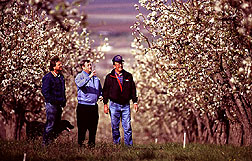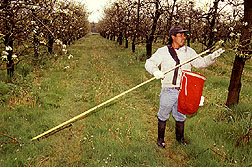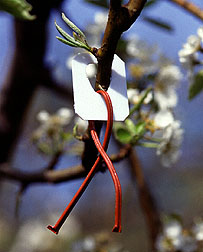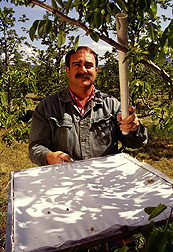IPM Goes Areawide
Large-scale, areawide pest management project may presage things to come as fruit growers back new approach to codling moth control.
"There's a real need for an integrated attack against insects," Biel says, "but as individual growers, we don't know how to do it. We need to cooperate and explore strategies, including nonchemical alternatives."
Help is on the way.
"To aid in this challenge, the Agricultural Research Service has implemented an areawide pest management initiative," says ARS national program leader Robert M. Faust. "This is part of USDA's effort to place 75 percent of all U.S. acreage under some form of integrated pest management (IPM) by the turn of the century."
Basically, IPM is a system that combines many crop pest control practices with careful monitoring of both pests and their natural enemies.
The key goals of IPM are to minimize disruptive pesticide usage and conserve natural enemies while producing an undamaged crop.
Critical to IPM is extensive knowledge of the timing of pest life cycles; methods to estimate damage thresholds, when remedial action must be taken; and availability of selective treatments.
The first areawide program to be funded will help Biele and other fruit growers, because it is aimed against the codling moth in the Pacific Northwest. It incorporates IPM technologies that have had only limited practice—in individual orchards—and applies them in contiguous orchards owned and managed by several growers.
Pest control is a major imperative in fruit production. Commercial apple and pear growers, for example, begin to lose money when insect damage exceeds just 1 percent of their crop.
|
|
However, "Chemical sprays are not as effective as they once were for controlling codling moths in our orchards," says John Biele, a fruit grower in northern Washington. "We find it necessary to spray more and more, because the moths keep building up their populations.
This program is being coordinated by the ARS Tree Fruit Research Laboratory [Since publication, the name of this facility was changed to the Yakima Agricultural Research Laboratory.] at Yakima, Washington, along with Washington and Oregon State Universities and the University of California at Berkeley.
While the main tactic for suppression will be mating disruption, other tactics will include Bacillus thuringiensis (Bt) sprays and parasite and sterile male codling moth releases over large areas.
Typically, IPM programs are conducted on individual orchards and are based mainly on chemical sprays for control. In some successful programs, chemical control has been expanded to larger areas and newer control strategies have also been used.
One such project involved cotton growers in the southeastern United States who were battling the destructive boll weevil.
Starting in 1978, there was a coordinated effort to apply chemicals to kill weevils that were making cotton production unprofitable for some growers. Less than 10 years later, the boll weevil was essentially wiped out in North and South Carolina.
|
Click here for table detailing the Codling Moth Pilot Project. |
Today, thanks to additional controls that include early plow-down of crop residue, introduction of natural enemies such as fungi and predatory insects, and use of bait traps, the insect is under control in parts of Florida, Alabama, Mississippi, Texas, Arizona, and California. In some cases, pesticide applications have been reduced from 12 a season to as few as 5 or 6.
An important lesson from this boll weevil control program is that success depends on a concerted, coordinated effort by all growers within a region.
Nonchemical Alternatives
More recent IPM programs have promoted nonchemical methods as the basis for pest control, with the use of pesticides a last resort.
"When farmers first planted apple trees in the Pacific Northwest about 95 years ago, they didn't need insecticides," says ARS entomologist Carrol O. Calkins.
"But by the 1920's, codling moths had become established, and growers were spraying trees once or twice a year. Now, some growers need to apply insecticides for codling moth control up to six times a year, as insecticide resistance increases."
Calkins heads a project at the ARS Tree Fruit Research Laboratory in Yakima, Washington, that is aimed at finding better ways to control insects in fruit trees with less reliance on chemical pesticides.
|
|
But this source of the proverbial "worm in the apple" is particularly difficult to control, because codling moths can survive on a wide array of other fruits including quince, wild hawthorn, crab apples, and English walnuts. Even when apple growers spray to control the pest in their trees, some moths survive on surrounding unsprayed hosts. These survivors can eventually invade and re-infest the apple orchards.
Another trait that favors codling moths' survival is that most of their lives—the larval stage—is spent inside fruit. This protects them from insecticides and environmental stresses, like extremely hot or cold weather.
Nevertheless, Calkins and other scientists believe pesticide use to control codling moths can be reduced—and perhaps eventually eliminated—by the use of pheromones, biocontrol agents, and release of sterile males.
Industry People Lend a Hand
The apple industry has an interest in making the areawide pest management system work.
"Codling moths, if left unchecked, have the potential to destroy an estimated 80 percent of the Northwest's apple crop and 50 percent of the pears," says Calkins.
"With evidence that pesticide resistance is becoming a problem at sites in California and Washington, it is time that we changed the orchard IPM system currently used and implemented alternatives to chemical-based management."
Test sites on commercial orchards are near Parker Heights, Oroville, and Chelan, Washington; Medford, Oregon; and Randall Island in the Sacramento River Delta south of Sacramento, California. They range in size from 300 to 1,100 acres and have 68 grower-participants.
|
|
"Growers have been involved in the project since the start," says Gaylord Enbom of Wapato, Washington. He grows 11 acres of apples and pears and is partner in another operation that consists of 120 acres of apples, pears, and cherries.
"We intend to cooperate to make sure this is a fair test of the system," Gaylord says, "because we have too much at stake not to. While we don't know that it will work, we hope it does. We're still in the learning stage at this point."
Some large growers are already using mating disruption on a fairly large scale—500 to 1,000 acres. They tie sex pheromone dispensers on trees to confuse codling moth males looking for mates. The dispensers flood orchards with so much synthetic female moth scent that males find it all but impossible to find a potential mate. Some entomologists liken it to trying to find someone in a house of mirrors.
As a result of this confusion, females don't get mated, their eggs are not fertilized, and the population crashes. Because insecticides are not used, natural enemies such as parasites and predators are able to increase to the point that secondary pests such as leafrollers, pear psylla, aphids, and leafminers are also controlled.
"The goal is to get all orchards in a large area to function as a complex, sustainable ecosystem where insect populations never build to destructive levels," says Calkins. "This could take several years."
The technology for this project has already been developed piecemeal during the past 30 years at Yakima and at other ARS labs and universities. So the biggest challenge will be to fit all the pieces together.
|
Click here for a brief history of the evolution of IPM. |
"Mating disruption is the key to expanding the areawide pest management program on commercial fruit," says Alan L. Knight, an ARS entomologist at Yakima. "This is quite a change from all previous controls based on insecticides.
"Although we don't yet know the most effective ways to use disruption in all orchards, we do have recommendations for its use in most instances" he says. "During the past 3 years in apple and pear orchards with low moth populations, mating disruption has generally worked as well as insecticides. In more than 150 orchards, it proved successful 95 percent of the time."
"Our studies," says Calkins, "indicate that today's higher costs for mating disruption of codling moth can be reduced and made competitive with conventional insecticide control. This will happen if growers can rely on disruption to replace four or more sprays," he says, "and provided that we are able to control secondary pests economically."
Mass production of pheromone dispensers and competition from additional manufacturers should further reduce costs.
|
|
"And," Calkins adds, "once the insect pest populations are reduced throughout an area, fewer dispensers will be needed, and costs will continue to decrease."
Monitoring insect populations during the growing season will allow timely implementation of appropriate control measures. In the past, some growers were using intuition rather than insect counts to determine when to apply insecticides. Modern traps will provide needed data.
Changes in farming practices will also help. For example, removing crop residues can eliminate overwintering sites for moth larvae. Less labor-intensive methods include planting cover crops that help control weeds while providing food and a favorable habitat for desirable insects.
Additional cooperators in the ARS codling moth areawide pest management program include the Washington Tree Fruit Research Commission, county extension agents, farm advisers, Washington Apple Commission, and Winter Pear Control Committee.
Other areawide pest management programs under ARS consideration include tobacco budworm (a.k.a. cotton bollworm and corn earworm), Colorado potato beetle, pink bollworm, and corn rootworm. In addition, two weeds—leafy spurge and sicklepod—and a plant disease—tomato blight—are potential projects.—By Dennis Senft, ARS.
Alan L. Knight, and Thomas R. Unruh are at the USDA-ARS Yakima Agricultural Research Laboratory, 5230 Konnowac Pass Rd., Wapato, WA, 98951; phone (509) 454-6566 Knight, phone (509) 454-6563 Unruh, fax (509) 454-5646.
"IPM Goes Areawide" was published in the July 1995 issue of Agricultural Research magazine.











